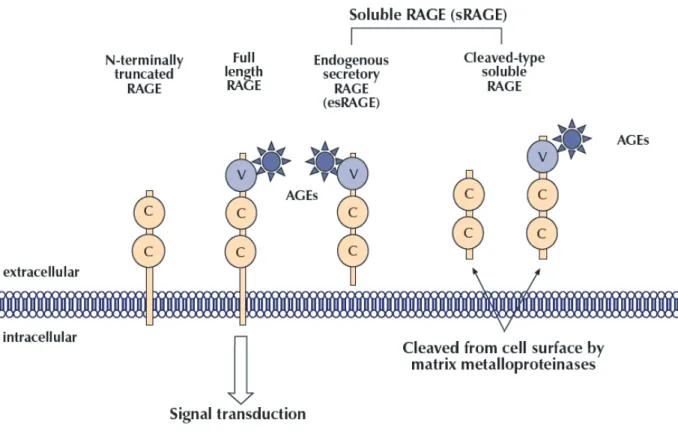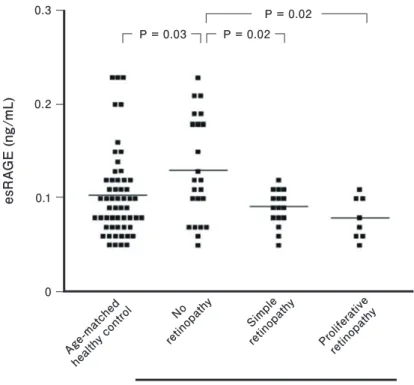Accepted : August 30, 2017 Published online : September 30, 2017
Glycative Stress Research 2017; 4 (3): 212-216
Review article
Masayuki Yagi, Yoshikazu Yonei
Anti-Aging Medical Research Center and Glycative Stress Research Center, Faculty of Life and Medical Sciences, Doshisha University, Kyoto, Japan
Glycative Stress Research 2017; 4 (3): 212-216 (c) Society for Glycative Stress Research
Glycative stress and anti-aging
5. Glycative stress and receptors for AGEs as ligands.
(総説論文
-日本語翻訳版)
糖化ストレスとアンチエイジング
5.糖化ストレスと AGEs 受容体
抄録
八木雅之、米井嘉一 同志社大学生命医科学部アンチエイジングリサーチセンター・糖化ストレス研究センター糖化ストレスによって血中や組織中に終末糖化産物(advanced glycation end products: AGEs)が蓄積する
と、生体内では生理的機能の低下や障害が進展する。AGEsには受容体を介した細胞内のシグナル伝達経路や
AGEsをトラップして除去する受容体の存在が確認されている。AGEsを認識する受容体のうちReceptor for
AGEs(RAGE)、AGE-R2は炎症に関与する。一方、AGE-R1、AGE-R3、CD36、SR-A、SR-BI、FEEL-1,2、
ERM、メガリンはAGEsの分解・除去に関与する受容体である。これらのAGEs受容体は血管、腎臓、神経、
マクロファージなど、さまざまな組織に存在する。生体内組織におけるRAGE発現は細胞内の炎症を惹起し、 臓器や組織障害をもたらす。このためRAGEの発現抑制は糖化ストレス抑制のターゲットになっている。一方、 AGEsを除去する受容体やsRAGEの発現制御は、今後の新たな糖化ストレス抑制につながる可能性がある。 連絡先: 教授 八木雅之 同志社大学生命医科学部アンチエイジングリサーチセンター・ 糖化ストレス研究センター
KEY WORDS:
終末糖化産物(Advanced glycation end products: AGEs)、AGEs 受容体(receptor for advanced glycation end products: RAGE)、細胞情報伝達(intracellular signaling)はじめに
糖化ストレスによって血中や組織中に終末糖化産物 (advanced glycation end products : AGEs) が 蓄 積 す る と、生体内では生理的機能の低下や障害が進展する。近年
の研究ではAGEs受容体を介した細胞内のシグナル伝達
経路やAGEsをトラップして除去する受容体の存在が確
認されている1-3)。AGEsの受容体は炎症に関与するもの、
AGEsの分解・除去に関与するものに大別される。前者に
はreceptor for AGEs(RAGE)、AGE-R2がある。後者に は AGE-R1、AGE-R3、CD36、SR-A、SR-BI、 FEEL-1, 2、ERM、メガリンなどがある(Fig. 1)2)。これらの受 容体は血管、腎臓、神経、マクロファージなど、さまざま な組織に存在する。
1.RAGE
RAGEは 分 子 量45kDaの イ ム ノ グ ロ ブ リ ン・ ス ー パーファミリー(immunoglobulin superfamily)に属す る 一 回 膜 貫 通 型 の 膜 蛋 白(single-pass transmembrane proteins の一種で、単球(monocyte)、マクロファージ(macrophage)、 神 経、 細 尿 管 細 胞(renal tubule cell)、
メサンギウム細胞(mesangial cell)などで発現してい
る。RAGEはAGEs以外にアミロイドβ蛋白(amyloid β protein)、S100 / calgranulins や high mobility group
box 1(HMGB-1)にも結合し、炎症や酸化ストレスの亢
進に関与している。
RAGEは 細 胞 外 に 存 在 す るVド メ イ ン、2つ のCド メ イ ン、 お よ び 細 胞 膜 貫 通 ド メ イ ン(transmembrane protein domain)、そして細胞内ドメイン (intracellular
protein domain) の、合わせて5つのドメインで構成され
ている(Fig. 2)4)。またRAGEには細胞表面に存在する全
長型(full length RAGE: F-RAGE)以外に、スプライシ
ングバリアント(splicing variant)として、細胞内ドメイ ン欠損型(C-terminally truncated RAGE: C-RAGE)、細 胞外Vドメイン欠損型(N-terminally truncated RAGE:
N-RAGE)が存在する5)。
このうち細胞内ドメイン欠損型RAGEは可溶性RAGE
(soluble RAGE: sRAGE)と呼ばれる。さらにsRAGEに
は細胞内で産生されて細胞外に分泌されるendogenous
secretory RAGE(esRAGE)と、F-RAGEが蛋白分解酵素 やmatrix metalloproteinases(MMP)である a disintegrin and metalloproteinase 10(ADAM 10)によって切断され て 血 中 に 放 出 さ れ るcleaved-type soluble RAGE( CL-RAGE)が存在する6)。
F-RAGEは細胞膜上でAGEsと結合すると、NADPH
オキシダーゼが活性化し、細胞内酸化ストレスを亢進し、 nuclear factor-kappa B(NF-kB)の活性化を介して、さ まざまなサイトカイン、増殖因子の分泌、接着因子の発現 を誘導する7)。また、酸化ストレスの亢進は、一酸化窒素 (nitric oxide: NO)を不活性化させ、炎症反応や血栓傾向 (thrombotic tendency)をさらに増悪させ、動脈硬化症の 進展に関わるものと考えられている。 またAGEs は、血管内皮細胞における血管内皮増殖因子
(vascular endothelial growth factor: VEGF)のオートク ライン(autocrine)産生を促進し、血管新生(angiogenesis) を誘導する8)。
さらにF-RAGEはAGEsと結合すると血管内皮細胞の
プロスタサイクリン(prostacyclin;PGI2)の産生を抑える
一方、プラスミノーゲンアクチベーターインヒビター–1
(plasminogen activator inhibitor-1: PAI-1) の合成を促進 し、線溶系(fibrinolytic system)を阻害して血栓の安定 化に関与する9)。AGEsは血小板の凝集を高めるとともに、 凝固系(coagulation system)のカスケードを促進させる ことも知られている。 一方、sRAGEはAGEsとの結合部位を持つため、細胞 外に存在するAGEsを捕捉し、細胞表面に存在するRAGE との結合を阻害するデコイ受容体(decoy receptor)とし て機能すると考えられている10)。2型糖尿病患者では、血 中esRAGEが非糖尿病患者に比べて有意に低く、2型糖尿 病の発症に関与する可能性が示唆されている11-12)。また 1型糖尿患者では血中esRAGE濃度の低い症例で網膜症の リスクが高いとの報告がある (Fig. 3)13)。さらに2型糖尿 病患者の血中esRAGE濃度は、頸動脈硬化や冠動脈疾患 の重症度と逆相関することも示されている14-15)。
2.AGE-R1, -R2, -R3 複合体
AGE-R1はOST-48(oligosaccharyltransferase-48)と
も呼ばれ、分子量48kDaのレクチンファミリー(lectin family) に 属 す る 一 回 膜 貫 通 型 蛋 白 の 一 種 で あ る。 AGE-R1は内皮細胞、メサンギウム細胞、マクロファージ などで発現し、エンドサイトーシス(endocytosis)によっ てAGEsを除去する。またAGE-R1は寿命延長に関与し ている可能性がある16)。
AGE-R2は80K-H(80 kDa protein kinase C substrate)
とも呼ばれ、分子量80kDaのチロシンリン酸化蛋白で細
胞質に存在する。AGE-R2は単核球、腎臓、血管内皮、脳、
神経などで発現し、細胞内シグナルの活性化に関与してい る。
AGE-R3はgalectin-3とも呼ばれ、分子量32kDaのレ
クチンファミリーに属する受容体である。AGE-R3は細胞 上の炭水化物認識ドメインを介してAGEsと直接結合し、 マクロファージ、好酸球、肥満細胞、神経、腎臓などで発 現する。AGE-R3の作用には細胞とマトリックスであるラ ミニン(laminin)との接着抑制、肥満細胞の活性化、細 胞増殖やアポトーシスの制御、エンドサイトーシスによる AGEsの分解などがある。さらにAGE-R3は加齢や糖尿病 において発現が増強することから、老化の抑制に作用して いる可能性がある17)。
Fig. 1. Receptors for AGEs.
The figure is quoted from Reference 2. AGEs, advanced glycation end products; RAGE, receptor for AGE; OST, oligosaccharyltransferase-48; 80K-H, 80 kDa protein kinase C substrate; LOX-1, Lectin-like oxidized low-density lipoprotein (LDL) 1; CD36, cluster of differentiation 36; SR-BI, scavenger receptor-BI; scavenger receptor class B type I; FEEL, fasciclin EFG-like laminin-type EGF-like and link domein-containing scavenger receptor.
Fig. 2. Various forms of receptor for AGEs (RAGE).
The figure is quoted from Reference 4. AGEs, advanced glycation end products; RAGE, receptor for AGE; sRAGE, soluble form of RAGE; esRAGE, endogenous secretory RAGE; C, immunoglobulin-like constant domains; V, immuoglobulin-like variable domains.
Fig. 1. Receptors for AGEs.
Fig. 3. Relationship of serum esRAGE to severity of retinopathy in type 1 diabetic patients.
Horizontal bars indicate mean of each group. Multiple comparison among diabetic subgroups was done by Scheffe’s F-test. Data are quoted from Reference 13. AGE, advanced glycation end product; RAGE, receptor for AGE; esRAGE, endogenous secretory RAGE.
3.SR-A、CD36、SR-BI、FEEL-1、
FEEL-2
SR-A、CD36、SR-BI、FEEL-1、FEEL-2は ス カ ベ ン ジャー受容体(scavenger receptor)とも呼ばれ、AGEs の分解排泄に作用している。
SR-A(scavenger receptor class A)はアセチル化LDL (low density lipoprotein)や酸化LDLをリガンドとして
認識し、マクロファージの細胞表面でAGEsを細胞内に取 り込んで泡沫化することから、動脈硬化の粥状化に関与す ることが示唆されている18)。 CD36(cluster of differentiation 36)はマクロファー ジ、血管内皮細胞、脂肪細胞表面で発現する。CD36は脂 肪酸、コラーゲン、 酸化LDLと結合し、酸化LDLのマク ロファージ内への取り込みや脂肪酸を脂肪細胞に運搬する 役割を担っている。CD36はAGEsを脂肪細胞内に取り込 ませてAGEsを分解除去するため、動脈硬化に対して保護 的な作用を及ぼすと推定されている19)。
SR-BI (scavenger receptor-BI)はマクロファージ、 肝臓、
副腎、卵巣などで発現し、HDL(high density lipoprotein) コレステロールエステルの肝臓への取り込みを促進する作 用がある20)。
FEEL-1(fasciclin EFG-like laminin-type EGF-like and link domein-containing scavenger receptor-1)、
FEEL-2は、脾臓、リンパ節に発現し、AGEsの細胞内取 り込み、分解に関与している21)。
4.メガリン
メガリン(megalin)は分子量約600 kDaの糖蛋白で、 LDL受容体遺伝子ファミリーに属し、近位細尿管細胞に 存在している22)。メガリンは主にビタミンD結合蛋白、レチ ノール結合蛋白、甲状腺ホルモン、インスリンなどの低分 子蛋白の再吸収、代謝に関与している。近年、メガリンは AGEと結合し、糸球体を通過したAGEsがメガリンによっ てトラップされ、ライソソーム(lysosome)に取り込まれ て分解されることがin vitro実験で報告されている23)。 0.3 0.2 0.1 0 es R A G E ( ng /m L) P = 0.02 P = 0.03 P = 0.02 Type 1 diabetes Ag e-matc hed healt hy c ontro l No retin opat hy Simp le retin opat hy Proli fera tive retin opat hy5.その他の AGEs 受容体
ERM(ezrin, radixin, meosin)蛋白は細胞膜と細胞内 アクチンフィラメントを連絡する蛋白で、細胞の構造変化、 運動生理、接着などの役割を担っている。近年、ERMファ ミリー蛋白のN末端はAGEsと結合することが報告され ている24)。
6.糖化ストレス抑制と AGE 受容体
AGEsとRAGEの結合は細胞内の酸化ストレスを亢進 し、サイトカインを発現させて細胞内に炎症を惹起し、臓 器や組織障害を起こす。このため糖化ストレスを抑制に はRAGEの発現抑制がターゲットのひとつとなる。一 方、AGE-R1やAGE-R3は臓器や組織を保護する役割を 果たす。さらにsRAGEはAGEsに対してデコイ的に働 き、RAGEの発現による炎症惹起を抑制し、さまざまな疾 患の進展を抑制する。このためAGEsを除去する受容体や sRAGEの発現制御は、今後の新たな糖化ストレス抑制手 段になる可能性がある。謝辞
本研究の一部は、総合科学技術・イノベーション会議の SIP(戦略的イノベーション創造プログラム 研究課題番号 14 5335679) 「次世代農林水産業創造技術」 (農研機構生研 センター委託研究) によって実施された。利益相反申告
本研究を遂行するにあたり利益相反に該当する事項は ない。1) Goldin A, Beckman JA, Schmidt AM, et al. Advanced glycation end products: Sparking the development of diabetic vascular injury. Circulation. 2006; 114: 597-605. 2) Nagai R, Jinno M, Ichihashi M, et al. Advanced glycation
end products and their receptors as risk factors for aging. Anti-Aging Med. 2012; 9: 108-113.
3) Yamamoto Y, Yamamoto H. Controlling the receptor for advanced glycation end-products to conquer diabetic vascular complications. J Diabetes Investig. 2012; 3: 107-114.
4) Katakami N, Matsushima M, Kaneto H, et al. Endogenous secretory RAGE but not soluble RAGE is associated with carotid atherosclerosis in type 1 diabetes patients. Diab Vasc Dis Res. 2008; 5: 190-197.
5) Sakurai S, Yonekura H, Yamamoto Y, et al. The AGE-RAGE system and diabetic nephropathy. J Am Soc Nephrol. 2003; 14: S259-S263.
6) Raucci A, Cugusi S, Antonelli A, et al. A soluble form of the receptor for advanced glycation endproducts (RAGE) is produced by proteolytic cleavage of the membrane-bound form by the sheddase a disintegrin and metalloprotease 10 (ADAM10). FASEB J. 2008; 22: 3716-3727.
7) Cipollone F, Iezzi A, Fazia M, et al. The receptor RAGE as a progression factor amplifying arachidonate-dependent inflammatory and proteolytic response in human atherosclerotic plaques: Role of glycemic control. Circulation. 2003; 108: 1070-1077.
8) Bucciarelli LG, Wendt T, Qu W, et al. RAGE blockade stabilizes established atherosclerosis in diabetic apolipoprotein E-null mice. Circulation. 2002; 106: 2827-2835.
9) Soro-Paavonen A, Watson AM, Li J, et al. Receptor for advanced glycation end products (RAGE) deficiency attenuates the development of atherosclerosis in diabetes. Diabetes. 2008; 57: 2461-2469.
10) Yonekura H, Yamamoto Y, Sakurai S, et al. Novel splice variants of the receptor for advanced glycation end-products expressed in human vascular endothelial cells and pericytes, and their putative roles in diabetes-induced vascular injury. Biochem J. 2003; 370: 1097-1109. 11) Koyama H, Shoji T, Yokoyama H, et al. Plasma
level of endogenous secretory RAGE is associated with components of the metabolic syndrome and atherosclerosis. Arterioscler Thromb Vasc Biol. 2005; 25: 2587-2593.
12) Choi KM, Yoo HJ, Kim HY, et al. Association between endogenous secretory RAGE, inflammatory markers and arterial stiffness. Int J Cardiol. 2009; 132: 96-101. 13) Sakurai S, Yamamoto Y, Tamei H, et al. Development
of an ELISA for esRAGE and its application to type 1 diabetic patients. Diabetes Res Clin Pract. 2006; 73: 158-165.
14) Katakami N, Matsuhisa M, Kaneto H, et al. Serum endogenous secretory RAGE levels are inversely associated with carotid IMT in type 2 diabetic patients. Atherosclerosis. 2007; 190: 22-23.
15) Lu L, Pu LJ, Zhang Q, et al. Increased glycated albumin and decreased esRAGE levels are related to angiographic severity and extent of coronary artery disease in patients with type 2 diabetes. Atherosclerosis. 2009; 206: 540-545. 16) Cai W, He JC, Zhu L, et al. High levels of dietary
advanced glycation end products transform low-density lipoprotein into a potent redox-sensitive mitogen-activated protein kinase stimulant in diabetic patients. Circulation. 2004; 110: 285-291.
17) Pugliese G, Pricci F, Leto G, et al. The diabetic milieu modulates the advanced glycation end product-receptor complex in the mesangium by inducing or upregulating galectin-3 expression. Diabetes. 2000; 49: 1249-1257. 18) Nagai R, Matsumoto K, Ling X, et al. Glycolaldehyde, a
reactive intermediate for advanced glycation end products, plays an important role in the generation of an active ligand for the macrophage scavenger receptor. Diabetes. 2000; 49: 1714-1723.
19) Ohgami N, Nagai R, Ikemoto M, et al. Cd36, a member of the class b scavenger receptor family, as a receptor for advanced glycation end products. J Biol Chem. 2001; 276: 3195-3202.
20) Krieger M. Scavenger receptor class B type I is a multiligand HDL receptor that influences diverse physiologic systems. J Clin Invest. 2001; 108: 793-797. 21) Tamura Y, Adachi H, Osuga J, et al. 1 and
FEEL-2 are endocytic receptors for advanced glycation end products. J Biol Chem. 2003; 278: 12613-12617.
22) Farquhar MG, Saito A, Kerjaschki D, et al. The Heymann nephritis antigenic complex: Megalin (gp330) and RAP. J Am Soc Nephrol. 1995; 6: 35-47.
23) Saito A, Kazama JJ, Iino N, et al. Bioengineered implantation of megalin-expressing cells: A potential intracorporeal therapeutic model for uremic toxin protein clearance in renal failure. J Am Soc Nephrol. 2003; 14: 2025-2032.
24) McRobert EA, Gallicchio M, Jerums G, et al. The amino-terminal domains of the ezrin, radixin, and moesin (ERM) proteins bind advanced glycation end products, an interaction that may play a role in the development of diabetic complications. J Biol Chem. 2003; 278: 25783-25789.

